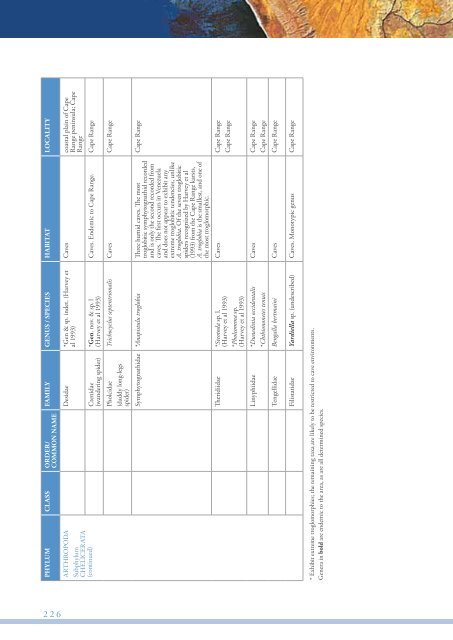Acknowledgements and Appendices - Department of the ...
Acknowledgements and Appendices - Department of the ...
Acknowledgements and Appendices - Department of the ...
Create successful ePaper yourself
Turn your PDF publications into a flip-book with our unique Google optimized e-Paper software.
FAMILY GENUS / SPECIES HABITAT LOCALITY<br />
PHYLUM CLASS ORDER/<br />
COMMON NAME<br />
2 2 6<br />
Caves coastal plain <strong>of</strong> Cape<br />
Range peninsula; Cape<br />
Range<br />
Desidae *Gen & sp. indet. (Harvey et<br />
al 1993)<br />
ARTHROPODA<br />
Subphylum<br />
CHELICERATA<br />
(continued)<br />
*Gen. nov. & sp. l<br />
Caves. Endemic to Cape Range. Cape Range<br />
(Harvey et al 1993)<br />
Trichocyclus septentrionalis Caves Cape Range<br />
Ctenidae<br />
(w<strong>and</strong>ering spider)<br />
Pholcidae<br />
(daddy long-legs<br />
spider)<br />
Cape Range<br />
Symphytognathidae *Anapistulu troglobia Three humid caves. The most<br />
troglobitic symphytognathid recorded<br />
<strong>and</strong> is only <strong>the</strong> second recorded from<br />
caves. The first occurs in venezuela<br />
<strong>and</strong> does not appear to exhibit any<br />
extreme troglobitic tendencies, unlike<br />
A. troglobia. Of <strong>the</strong> seven troglobitic<br />
spiders recognized by Harvey et al<br />
(1993) from <strong>the</strong> Cape Range karsts,<br />
A. troglobia is <strong>the</strong> smallest, <strong>and</strong> one <strong>of</strong><br />
<strong>the</strong> most troglomorphic.<br />
Caves Cape Range<br />
Cape Range<br />
Theridiidae *Steotoda sp. l.<br />
(Harvey et al 1993)<br />
*Pholcomma sp.<br />
(Harvey et al 1993)<br />
Linyphiidae *Dunedinia occidentalis Caves Cape Range<br />
*Chthiononetes tenuis<br />
Cape Range<br />
Tengellidae Bengalla bertmaini Caves Cape Range<br />
Filistatidae Yardiella sp. (undescribed) Caves. Monotypic genus Cape Range<br />
* Exhibit extreme troglomorphies; <strong>the</strong> remaining taxa are likely to be restricted to cave environments.<br />
Genera in bold are endemic to <strong>the</strong> area, as are all determined species.
















